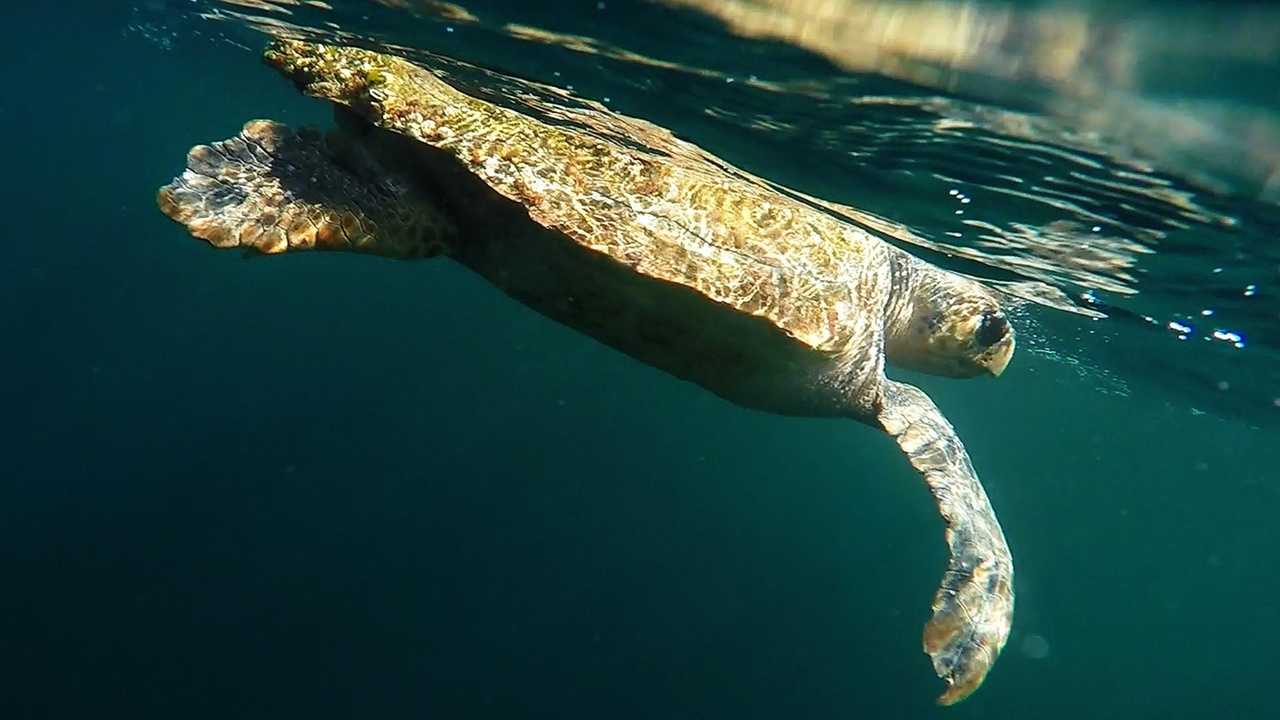Fun Facts About Terrific Sea Turtles
All six species of turtles in U.S. waters are protected under the Endangered Species Act. Here you can find out more about them and why their numbers have been declining.

What is the rarest of all sea turtles?

The Kemp's ridley turtle is the rarest of all sea turtles. It weighs between 80-100 pounds and the mature adult is an olive green color. They nest in large numbers known as "arribadas."
They have declined significantly in recent years due mainly to predation and poaching. Their nesting areas have dwindled to a single beach near Rancho Nuevo, Mexico.
In 1947, 40,000 ridleys nested. In 1981 the number was less than 500. Ridley turtles live in the waters of the North Atlantic and the Gulf of Mexico. On rare occasions, ocean currents have swept ridleys as far as Europe.
How long can sea turtles stay underwater?
When they are active, sea turtles must swim to the ocean surface to breathe every few minutes. When they are resting, they can remain underwater for as long as 2 hours without breathing.
Where do sea turtles breed?
Although sea turtles live most of their lives in the ocean, adult females must return to land in order to lay their eggs. Scientists believe that nesting female turtles return to the same beach on which they were born. Often sea turtles must travel long distances from their feeding grounds to their nesting beaches. Just how sea turtles find their nesting beaches is unknown.
Are sea turtles endangered?

All six species of sea turtles in the U.S. are protected under the Endangered Species Act (ESA). These are the green, hawksbill, Kemp's ridley, leatherback, loggerhead and olive ridley sea turtles.
The hawksbill, Kemp's ridley, and leatherback sea turtles are listed as endangered under the ESA. Breeding populations of olive ridley sea turtles on the Pacific coast of Mexico are listed as endangered.
The loggerhead, green and olive ridley sea turtles are listed as threatened.
Do turtles get stranded like whales?
Stranding is common problem among sea turtles in the northern Atlantic. This can occur when a turtle becomes trapped in northern waters during the winter months. Scientists think that migration, distribution, and current patterns may influence these entrapments. Frigid water temperatures reduce the turtles' body temperatures below normal and they wash ashore in a condition called "cold-stunned." This type of stranding is not unusual and happens to loggerhead and ridley sea turtles. Each winter, several cold-stunned turtles are rescued from Cape Cod beaches and taken to the New England Aquarium. They are rehabilitated as part of the aquarium's Marine Animal Rescue and Rehabilitation program.
What about green sea turtles?
The green sea turtle is a medium to large brownish sea turtle with a radiating or mottled pattern of markings on the shell. The head is small in comparison to the other sea turtles and the biting edge of the lower jaw is serrated. Adult shell lengths range in size from 36-43 inches and weights average 200-300 pounds. They are primarily a tropical herbivorous species. Young turtles live in Florida waters, especially in areas abundant with sea grasses. The greatest cause of decline for green turtles has been commercial harvest for eggs and food, as well as leather and jewelry.
What is the largest sea turtle?

The leatherback is the largest sea turtle. Individuals have attained a shell length of 6 feet and weights of 1,400 pounds. Unlike other species of sea turtle, the leatherback does not have scales. Instead, it is covered with a firm, rubbery skin with seven longitudinal ridges or keels. Leatherback sea turtles are a highly migratory species. They nest in the tropics and range as far north as Canada and the northern Pacific ocean. The leatherback sea turtle feeds primarily on jellyfish. They face significant threats from bycatch in commercial fisheries, marine pollution, and the harvest of eggs and flesh.
What is a Turtle Excluder Device?
The Turtle Excluder Device or TED is a grid of bars with an opening either at the top or the bottom. The grid is situated back in the shrimp trawl before the bag. Small animals like shrimp slip through the bars and are caught in the bag end of the trawl. Large animals such as turtles and sharks, when caught in the trawl, strike the grid bars and are ejected out of the net through the opening.
Watch how reducing bycatch helps sea turtle populations